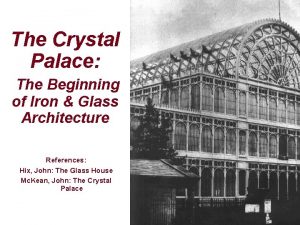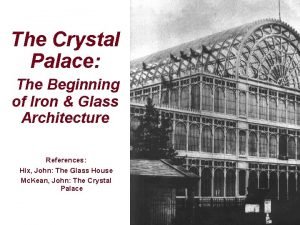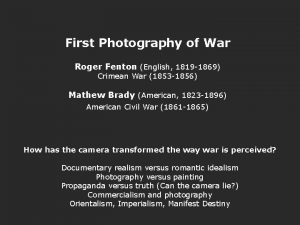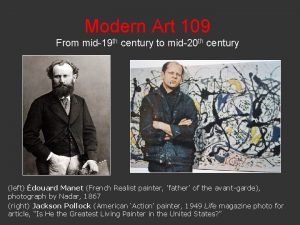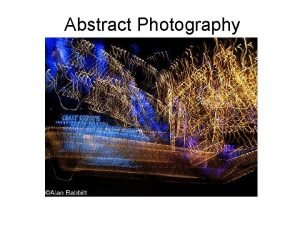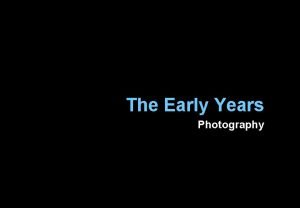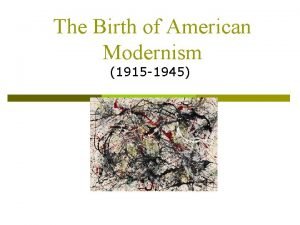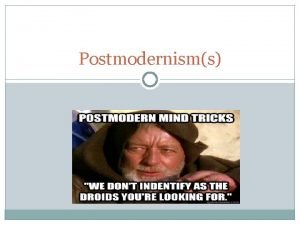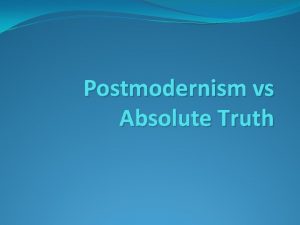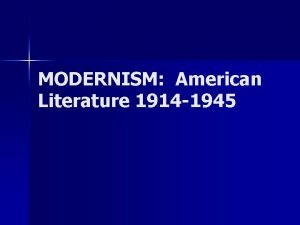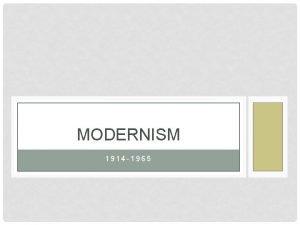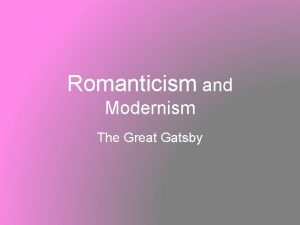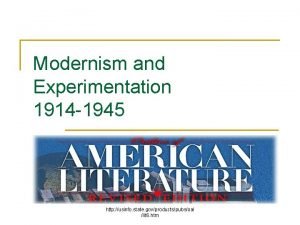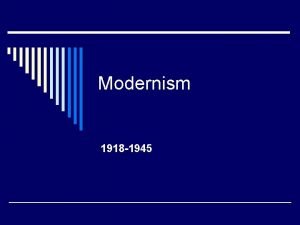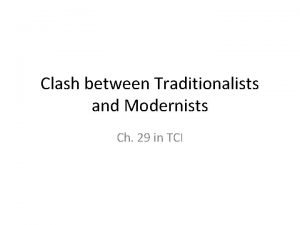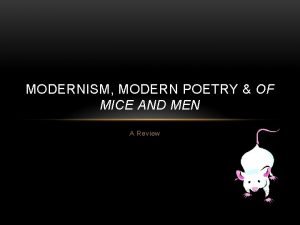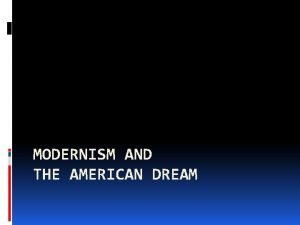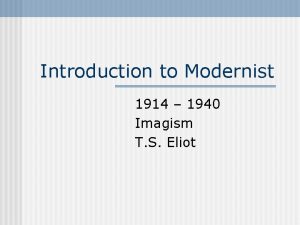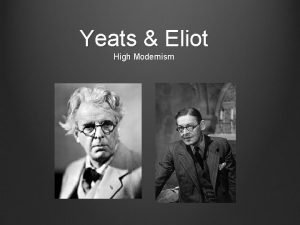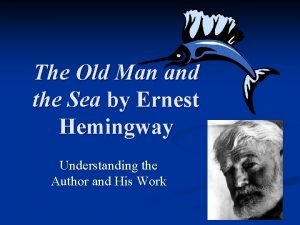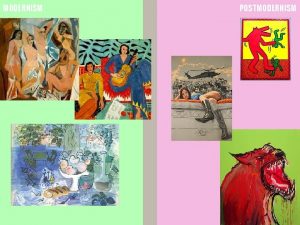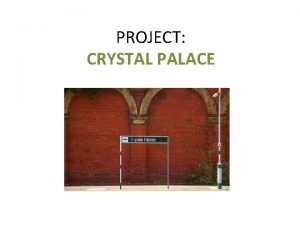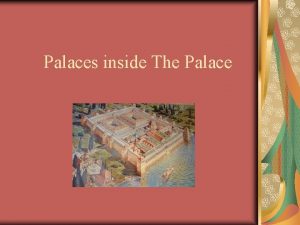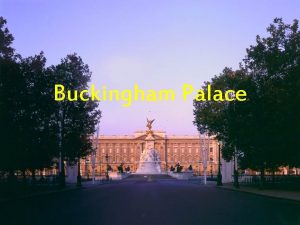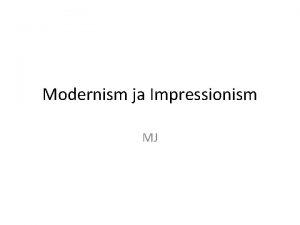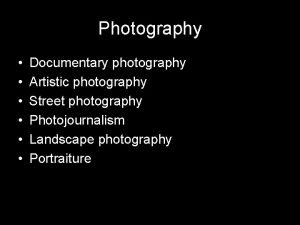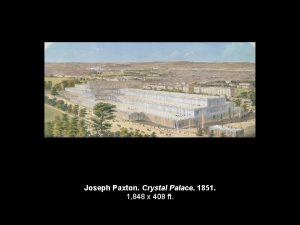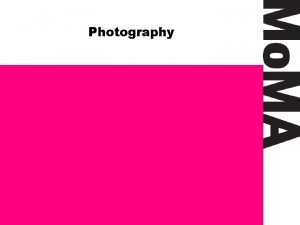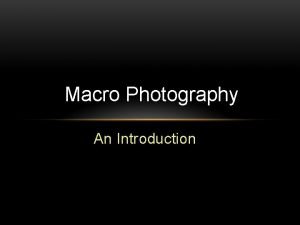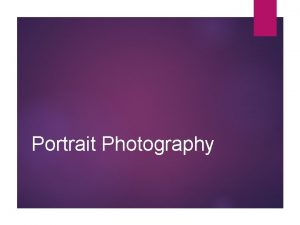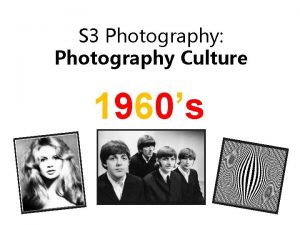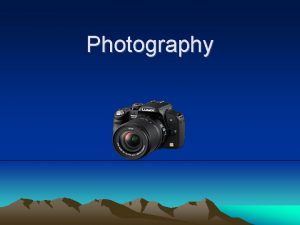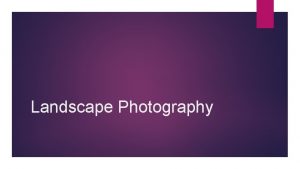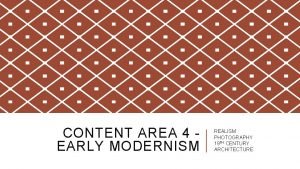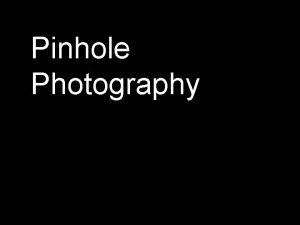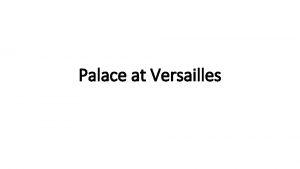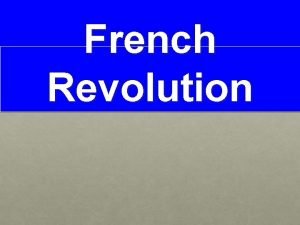Modernism The Crystal Palace and Early Photography JOSEPH




![(left) “Waiting for the Queen [Queen Victoria], ” Orientalist interior décor of Crystal Palace, (left) “Waiting for the Queen [Queen Victoria], ” Orientalist interior décor of Crystal Palace,](https://slidetodoc.com/presentation_image_h/0c878edd0325b59afa58f190707f6ae5/image-5.jpg)
































- Slides: 37

Modernism: The Crystal Palace and Early Photography

JOSEPH PAXTON (English, 1801 -1865) Crystal Palace, London, England, 1850– 1851. Photo from Victoria and Albert Museum, London. Moved in 1852, burned down in 1936. Marks the beginning of “Modern” architecture

Joseph Paxton, Crystal Palace, 1851

Building The Crystal Palace in six months from prefabricated iron parts
![left Waiting for the Queen Queen Victoria Orientalist interior décor of Crystal Palace (left) “Waiting for the Queen [Queen Victoria], ” Orientalist interior décor of Crystal Palace,](https://slidetodoc.com/presentation_image_h/0c878edd0325b59afa58f190707f6ae5/image-5.jpg)
(left) “Waiting for the Queen [Queen Victoria], ” Orientalist interior décor of Crystal Palace, an illustration by Joseph Nash for Dickinson's Comprehensive Pictures of the Great Exhibition of 1851 Two Beefeaters on guard at the entrance to the Crystal Palace, Hyde Park Ornamental cover for joints of iron girders (disguising modernity’s machine-tooled functionalism)

Silver table top sculpture shown in Great Exhibition of 1851 Victorian Orientalism

1851 cartoon from Punch, the British satirical magazine, about the exhibition of peoples from European colonies at the Great Exhibition of 1851 (inside the Crystal Palace)

Crystal Palace science & technology exhibits: - Envelope-making Machine

Compare “modern” commodities: bed and new railroad cars exhibited at Great Exhibition of 1851 (Crystal Palace)

Photography: The New Medium That Changed Art Fundamentally Joint Meeting of the Academies of Sciences and Fine Arts in the Institute of France, Paris, August 19, 1839

BEFORE PHOTOGRAPHY Photography was not a bastard left by science on the doorstep of art, but a legitimate child of the Western pictorial tradition. Peter Galassi

Leonardo Da Vinci, Draughtsman Using a Transparent Plane to Draw an Armillary Sphere, 1510

Illustration of Leonardo’s perspective grid

illustration from the book The Practice of Perspective, by Jean Dubreuil, 1642, showing an artist using a perspective glass

Albrecht Durer, Artist using a glass to take a portrait, 1525, woodcut.

Albrecht Durer, The painter studying the laws of foreshortening, 1525, woodcut. Draughtsmen plotting points for the drawing of a lute in foreshortening.

Before Photography: Western art’s quest for “Realism” leads to the invention of photography Photography relies on two scientific principles : 1) A principle of optics on which the Camera Obscura is based 2) Principle of chemistry, that certain combinations of elements, especially silver halides, turn dark when exposed to light (rather than heat or exposure to air) was demonstrated in 1717 by Johann Heinrich Schulze, professor of anatomy at the University of Altdorf

Palmer and Longking Daguerreotype Camera ca. 1854 on Iron Center Tripod

LOUIS-JACQUES-MANDÉ DAGUERRE (French, 1787 -1851), Still Life in Studio, 1837. Daguerreotype. Collection Société Française de Photographie, Paris. A daguerreotype cannot be reproduced. It is a unique image on metal plate.

William Henry Fox Talbot, The Open Door, calotype, 1843 one of 24 images in the first book illustrated by photographs, The Pencil of Nature “Calotype” was derived from the Greek kallos, “beauty” The calotype is the prototype of photography as we know it because it produced a “negative” on paper that could be reproduced.

Photography and painting have had an incalculable influence on each other. Eugène Delacroix, Odalisque, 1855. Oil on wood, and photographic study

Honoré Daumier, Nadar Elevating Photography to the Heights of Art, 1862, lithograph commemorating a court decision acknowledging photography as an art form protected by copyright law.

NADAR, Portrait of Jules Verne, n. d. , pioneer science fiction novelist. Journey To The Center Of The Earth (1864), Twenty Thousand Leagues Under The Sea (1870), and Around the World in Eighty Days (1873).

NADAR, Portrait of Georges Sand, 1877

JULIA MARGARET CAMERON (English, 18151879), Ophelia, Study no. 2, 1867. Albumen print, 1' 11" x 10 2/3". wet-plate technology

CAMERON, Annie, My First Success, 1864, albumen print. (right) Collodion (wetplate) camera. Process invented in 1851

JULIA MARGARET CAMERON, Portrait of Charles Darwin, 1868

CAMERON, The Echo, 1868

Mathew Brady (American, 1823 -1896) Mathew Brady’s Picture Gallery, New York “Brady of Broadway” In 1839 Brady met, and became a student to Samuel Morse. That same year he met Louis Daguerre in Paris and went back to the United States to capitalize upon the invention of the Daguerreotype, establishing a highly successful gallery.

Brady’s “Outfit for War” 1862: Brady's team used the collodion process. The limitations of equipment and materials prevented any action shots, but the photographers brought back some seven thousand pictures portraying the realities of war.

Alexander Gardner (studio of Mathew Brady), Dead at Antietam Church, 1862

TIMOTHY O’SULLIVAN (U. S. , 1840 -1882), A Harvest of Death, Gettysburg, Pennsylvania, July 1863. Collodion (wet-plate) process. O’Sullivan belonged to Matthew Brady’s team of Civil War photographers.

Compare representations of war: (top) Emmanuel Leutze, George Washington Crossing the Delaware, 1851 (bottom) Timothy O’Sullivan, Dead Soldier, 1863

Anonymous photographer, California Gold Rush, 1850 s Charles Christian Nahl, American (born Germany, 1818 -1878), Sunday Morning in the Mines, 1872, oil on canvas, 72 x 108”

Albert Bierstadt (German-born American Hudson River School Painter, 1830 -1902) Emigrants Crossing the Plains, 1867 Manifest Destiny Will Soule (U. S. , 1836 -1908) Indian Gallery, 1870 -75

Eadweard Muybridge (English, 1830 -1904) Horse Galloping, 1878. Muybridge is known primarily for his early use of multiple cameras to capture motion, and his zoopraxiscope, a device for projecting motion pictures that pre-dated the celluloid film strip still used today. http: //upload. wikimedia. org/wikipedia/commons/d/dd/Muybridge_race_horse_animated. gif

Eadweard Muybridge, Zoopraxiscope, (“wheel of life”), 1879. First machine patented in the U. S. to show moving pictures.
 Crystal palace architecture analysis
Crystal palace architecture analysis Crystal palace
Crystal palace Crystal palace
Crystal palace Crystal palace
Crystal palace Mid19
Mid19 Is abstract photography same as conceptual photography
Is abstract photography same as conceptual photography Early years photography
Early years photography Early cpr and early defibrillation can: *
Early cpr and early defibrillation can: * American modernism characteristics
American modernism characteristics Modernism vs postmodernism literature
Modernism vs postmodernism literature Pre-modernism
Pre-modernism Modernist realism
Modernist realism Modernism and the american dream
Modernism and the american dream The great gatsby modernism
The great gatsby modernism Experimentation in modernism
Experimentation in modernism Differences between realism and modernism
Differences between realism and modernism Chapter 29 the clash between traditionalism and modernism
Chapter 29 the clash between traditionalism and modernism Of mice and men modernism
Of mice and men modernism Modernism and the american dream
Modernism and the american dream Imagism and modernism
Imagism and modernism Leda and the swan modernism
Leda and the swan modernism The old man and the sea modernism
The old man and the sea modernism What is postmodernism
What is postmodernism Hình ảnh bộ gõ cơ thể búng tay
Hình ảnh bộ gõ cơ thể búng tay Bổ thể
Bổ thể Tỉ lệ cơ thể trẻ em
Tỉ lệ cơ thể trẻ em Chó sói
Chó sói Glasgow thang điểm
Glasgow thang điểm Bài hát chúa yêu trần thế alleluia
Bài hát chúa yêu trần thế alleluia Môn thể thao bắt đầu bằng chữ đua
Môn thể thao bắt đầu bằng chữ đua Thế nào là hệ số cao nhất
Thế nào là hệ số cao nhất Các châu lục và đại dương trên thế giới
Các châu lục và đại dương trên thế giới Công thức tính thế năng
Công thức tính thế năng Trời xanh đây là của chúng ta thể thơ
Trời xanh đây là của chúng ta thể thơ Mật thư tọa độ 5x5
Mật thư tọa độ 5x5 Làm thế nào để 102-1=99
Làm thế nào để 102-1=99 độ dài liên kết
độ dài liên kết
